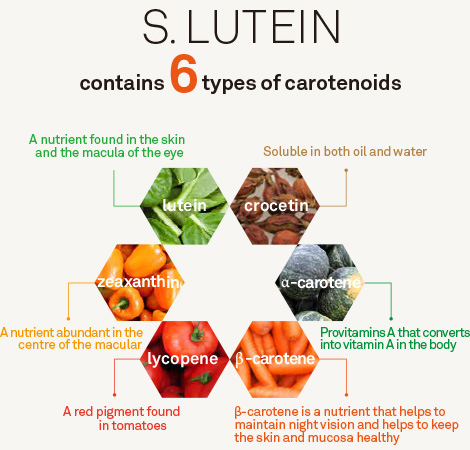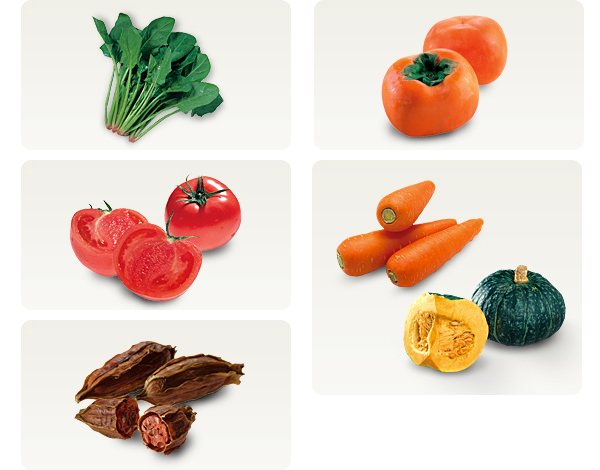
Lutein is a kind of yellow-orange pigment. In foods, large amounts of lutein are found in kale, the renowned ingredient of "aojiru" (green juice), as well as spinach, a type of yellow-green vegetable. Lutein can be found in the eye and skin, more specifically, it can be found in large quantities in the macular region of the eyes, but it cannot be synthesised by the human body.
Zeaxanthin is a yellow-orange pigment, with characteristics similar to those of lutein. It is found in large quantities in maize and Fuyu persimmons, as well as other foods such as green tea, egg yolk, animal fat and the liver. Like lutein, it can also be found in the macular area of the eye. However, according to recent research findings, the highest concentration of zeaxanthin can be found in the central region of the macular.
Crocetin is a pigment extracted from the gardenia fruit or the saffron stigma. It has amphipathic properties and dissolves in both water and oil. One of its important properties is due to its small molecule size, which allows it to be absorbed quickly and efficiently by the body. Even amongst the phytochemicals, the crocetin has captured the attention of researchers around the world for its ability to reach body tissues that are not easily accessible by other carotenoids.
It is said that lycopene is produced in tomatoes to protect them from sunlight while they ripen by absorbing sunrays. As the old European saying goes, "When tomatoes turn red, the doctor's face turns green" (A tomato a day keeps the doctor away). Today, various research findings have helped us realise that lycopene is a beneficial ingredient. Compared to absorption by eating raw vegetables, lycopene is more easily absorbed by consuming processed foods. Given its oil-soluble nature, cooking foods containing lycopene with some oil can enhance the absorption of lycopene by the body.
Both α- and β-carotene are found in the yellow and orange pigments of carrots and pumpkin. Known to be very safe, they have been used as a colour addictive in foods, drinks and cosmetics since ancient times. Carotenes will be transformed into vitamin A according to the needs of the body. As they are important to the body, specialists have been actively conducting research on them for many years. Before they are converted to vitamin A, they play the role of supporting overall health as one of the phytochemicals – a carotenoid component. The amount of vitamin A contained in S. LUTEIN meets the Japanese national standard for nutritional supplements.


Anthocyanins are blue-violet pigments found in blackcurrants and blueberries. A type of polyphenol, anthocyanins were the first to gain prominence among phytochemicals. Research on its properties was inspired by an anecdote from World War II, where a British pilot reportedly attributed his excellent vision, even in the dark, to his love of blueberry jam.
DHA (docosahexaenoic acid) is an unsaturated fatty acid found abundantly in fish oil and is known for its nutritional value for growing children. It is also found in breast milk and in all cells, especially those in the brain, where it plays a significant role in cerebral formation. It is said that the traditional fish-based diet of the Japanese is the main contributing factor to their longevity. There seems to be a close relationship between DHA and a healthy life.
We generate energy necessary to carry out daily activities from protein, carbohydrates, and fats – the three major nutritional substances contained in our food. B group vitamins act as a coenzyme in this process. They are also water-soluble. B group vitamins are essential nutrients to maintain our overall health.
Vitamin E is a fat-soluble vitamin that is known to play a role as an antioxidant in the body. It is believed that taking it during a meal with some fats in it will allow optimal absorption.
